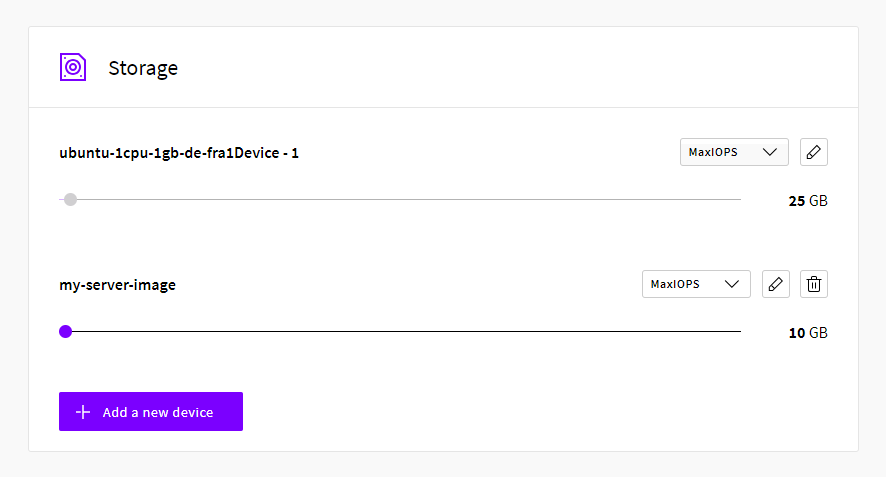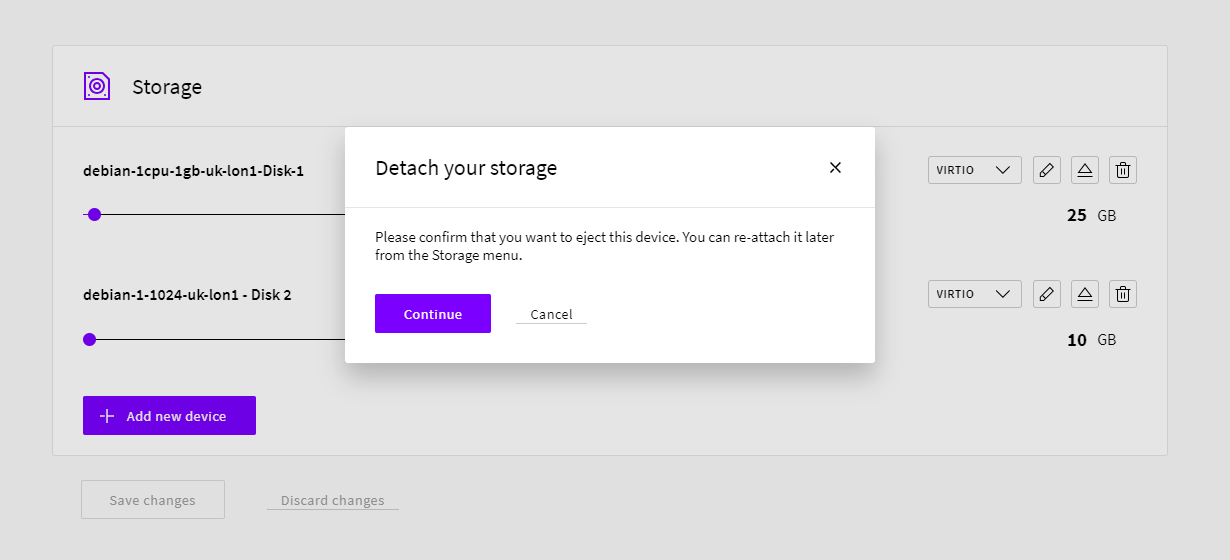How to Upload Image to Vmware Workstation
If yous already have a running virtual Linux host on a VMware hypervisor, but would like to take advantage of the scalable hardware and MaxIOPS storage technology, information technology is possible to import VMware systems to UpCloud. To get your existing server running in the cloud you volition need to upload the server epitome to a new cloud host, convert it to the RAW format, copy the converted epitome to a new storage drive, and reconfigure the host. This migration guide goes through each stride in detail to help you transfer pre-existing virtual servers to the cloud.
Please note that only Linux based virtual hosts can be imported. Windows Servers need to exist deployed using the templates provided by UpCloud due to licensing reasons.
Test hosting on UpCloud!
Deploying a new server
To start off, log in to your UpCloud control console and deploy a new server. You tin choose whichever flavour of Linux yous adopt, merely for convenience, you could use the same distro equally the system image you are migrating.
The new server will be used to download, convert and set up the prototype existence imported. Consider the following when making the configurations:
- Selecting the location you wish to import the server
- Choose the configuration, the 1CPU and 1GB elementary plan works fine
- Add together a second storage disk past clicking the Add a new device push and choose the size, it tin be scaled up later

- Pick the Os you are comfy with for a i fourth dimension kicking
- Include any SSH keys yous wish if available to allow password-costless login
- Naming your server and giving information technology a clarification.
- Confirm your selections and click the Deploy button.
In one case the configurations are done, hit the Deploy server button. Expect a few seconds for the server to commencement, then log into the newly deployed host to keep.
Update the system to make certain the software is running the latest versions.
# Debian and Ubuntu sudo apt-get update && sudo apt-go dist-upgrade -y # CentOS sudo yum update -y
With the new server upwards to date, check that both of the storage drives are attached and report their size correctly.
lsblk
NAME MAJ:MIN RM SIZE RO Blazon MOUNTPOINT vda 253:0 0 25G 0 deejay └─vda1 253:ane 0 25G 0 office / vdb 253:16 0 10G 0 disk
Here the vda disk with a partition chosenvda1 is your primary storage and the vdb disk as the secondary device without partitions. If everything seems in order, continue with uploading to import VMware system image to your cloud server.
Importing VMware system image
Depending on your VMware hypervisor configuration the organization storage deejay might exist stored in one or more files. The VMware virtual disk files are ordinarily named the same as your virtual organization and have a .vmdk file extension. You lot will need to re-create the .vmdk files to the new cloud host, for case, using Secure Copy, SFTP or rsync.
You can find out about some of the unlike secure file transfer options in the beginning section Encrypt communications in the commodity for how to secure your Linux cloud server. Depending on your VMware organization and your network connectedness it may be useful to compress the disk files for the transfer and then uncompress over again on the target host.
Once you have finished uploading the system prototype files, you volition need to convert them from a VMware epitome to the RAW format. The file format tin can be converted using the qemu-img utility available through the package managers on nigh Linux distributions. With Ubuntu and other Debian based systems, it is included in the qemu-utils package while on CentOS it can be installed past itself.
# Debian and Ubuntu sudo apt-become install qemu-utils # CentOS sudo yum install qemu-img
With the required utilities installed, convert the VMware image to RAW format with the control below. Supplant VMware_image with the name of your VMware virtual deejay file and the RAW_image with what y'all wish to telephone call the new image file.
qemu-img convert -f vmdk -O raw VMware_image.vmdk RAW_image.img
Once the conversion is complete, copy the new RAW paradigm content to the secondary deejay. Replace the RAW_image with the converted disk file proper noun just as above.
dd if=RAW_image.img of=/dev/vdb bs=16M oflag=direct Afterwards, you can shut down the server and remove the quondam principal disk. Go to your UpCloud control console and the Storage tab at your server settings. Once the server is in the stopped state, click the eject icon on the chief storage device to remove it. The second disk, where yous just transferred the system image, volition then exist automatically set equally the new main device. In the same menu, you should likewise choose the disk controller.

VirtIO controller provides the all-time functioning, but if you have issues starting the server, try IDE as information technology has better compatibility with unlike operating systems.
You can then restart the server again to continue configuring the system.
Reconfiguring the imported system
The newly transferred operating system should now work with the cloud server. However, depending on your old network setting you lot may need to use the Web Console log into the server and fix any issues earlier the system will connect ordinarily. Go to your UpCloud control console, open up the Console tab under your server settings, and clickOpen up the console connection.
Now, log in with the credentials for the imported VMware host as yous did before transferring the server to the deject. One time in, check the network settings with the following command.
ip addr
UpCloud hosts have three network interfaces in the default configuration, public IPv4, private IPv4 and public IPv6 addresses, y'all might see something like to the example output beneath. Here the first interface eth0 is working only the other devices are not notwithstanding configured.
ane: lo: <LOOPBACK,UP,LOWER_UP> mtu 65536 qdisc noqueue state UNKNOWN grouping default link/loopback 00:00:00:00:00:00 brd 00:00:00:00:00:00 inet 127.0.0.ane/8 telescopic host lo valid_lft forever preferred_lft forever inet6 ::1/128 scope host valid_lft forever preferred_lft forever 2: eth0: <BROADCAST,MULTICAST,UP,LOWER_UP> mtu 1500 qdisc pfifo_fast country UP group default qlen grand link/ether 6e:d7:1b:bf:18:29 brd ff:ff:ff:ff:ff:ff inet 83.136.248.62/22 brd 83.136.251.255 scope global eth0 valid_lft forever preferred_lft forever inet6 fe80::6cd7:1bff:febf:1829/64 scope link valid_lft forever preferred_lft forever 3: eth1: <BROADCAST,MULTICAST> mtu 1500 qdisc noop state DOWN grouping default qlen thousand link/ether 6e:d7:1b:bf:e6:f2 brd ff:ff:ff:ff:ff:ff 4: eth2: <BROADCAST,MULTICAST> mtu 1500 qdisc noop state DOWN group default qlen grand link/ether 6e:d7:1b:bf:61:a8 brd ff:ff:ff:ff:ff:ff
Edit your network configuration files to friction match the network interface names listed in the command output. For example on Ubuntu and other Debian-based systems employ the command beneath to open the configuration file.
sudo nano /etc/network/interfaces
Add the following sections to the file. If the network interfaces on your server are named differently, utilize those names instead of eth0, eth1, etc.
car lo iface lo inet loopback car eth0 iface eth0 inet dhcp automobile eth1 iface eth1 inet dhcp auto eth2 iface eth2 inet6 auto
On CentOS and other Red Hat variants, the network interfaces are configured in individual files. These files are stored in the /etc/sysconfig/network-scripts/ directory, check the file names with the command below.
ls /etc/sysconfig/network-scripts/ | grep ifcfg-
So open up the starting time interface file for edit, for example, ifcfg-eth0.
sudo vi /etc/sysconfig/network-scripts/ifcfg-eth0
The file should read at to the lowest degree the following settings. In instance, ONBOOT is set to no, alter information technology to yes and save the file.
DEVICE=eth0 BOOTPROTO=dhcp ONBOOT=yes
You may need to do the same operation to other network interfaces, or simply create new configuration files if your old system only had i or ii interfaces.
Subsequently, reboot the server and try logging in with SSH. If the network is working you lot can offset using the new host as before with the added benefit of the freely scalable system resources and faster than SSD storage disks with MaxIOPS applied science.
Terminal steps
Congratulations, your imported VMware arrangement should now be up and running on a make new cloud host. In case you have whatsoever further problems with the network, you tin find boosted assistance with troubleshooting the connectivity at the guide about network issues with Linux host.
Also, if you meet issues with booting from the migrated system image, you can always adhere the quondam main disk over again and notice the uploaded VMware disk stored safely for another try without the need to wait for the image to upload again. Once yous are confident that the imported system is running properly, you tin go to the Storage carte du jour at your UpCloud control panel and delete the unnecessary storage device.
Source: https://upcloud.com/community/tutorials/import-vmware-images/
0 Response to "How to Upload Image to Vmware Workstation"
Publicar un comentario